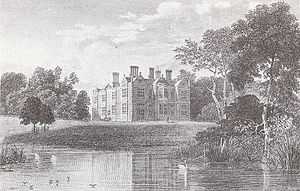Hungerford Crewe, 3rd Baron Crewe

Lord Crewe as caricatured by Spy (Leslie Ward) in Vanity Fair, January 1882
Hungerford Crewe, 3rd Baron Crewe FSA, FRS (10 August 1812 – 3 January 1894) was an English landowner and peer.
The son of John Crewe, 2nd Baron Crewe, an army general, and Henrietta Maria Anna Walker-Hungerford,[1][2] he was educated at Eton College and Christ Church, Oxford.[3] He was elected a fellow of the Society of Antiquaries in 1840 and of the Royal Society in 1841.[3][4]
Landlord and charitable works
On his father's death in 1835, he became the third Baron Crewe and inherited the Jacobean mansion of Crewe Hall in Cheshire, together with a large estate in Cheshire, Staffordshire and Leicestershire.[1] In 1871, he was the fifth greatest landowner in Cheshire, with a total of 10,148 acres (4,107 ha).[5] At his death in 1894, the total rents were estimated at £37,000 per year.[1] He appears to have been a relatively benevolent landlord, rebuilding farms, providing cottages and endowing schools.[1] In 1866, he paid more compensation to tenant farmers whose herds were affected by the cattle plague outbreak than was required by law.[6] He also made many charitable gifts, for example in Sandbach where he donated his income as lord of the manor to the local board, gave land for a town and market hall, and erected a drinking fountain.[1]
It was a period of rapid change: when he inherited the estate, the area to the west of Crewe Hall park was countryside with scattered farms; by his death it was occupied by the major railway centre of Crewe. He unsuccessfully opposed the construction of a Silverdale and Madeley Railway Company line from Newcastle-under-Lyme to Wrexham, which passed through the Crewe estate.[7]
Alterations to Crewe Hall

Lord Crewe commissioned Edward Blore to make alterations to Crewe Hall (1837–42). These included major changes to the plan of the building, redecoration of the interior in a Jacobethan style more sympathetic to the original Jacobean house, and modernisations including the installation of a warm-air heating system. Blore also added a centrepiece and clocktower to the stables quadrangle and built a gate lodge. The total cost of the works was £30,000.[8][9][10][11]
A fire gutted the main hall in January 1866.[12] Extensive restoration work was carried out for Lord Crewe by E. M. Barry, son of Sir Charles Barry, the architect of the Palace of Westminster (1866–70).[8][9][10] Barry added a tower to the west wing; required for water storage, the tower was intended to unite the east and west wings of the hall. He also reorganised the plan of the ground floor.[8] The gardens were redesigned after the fire by W. A. Nesfield, and his son William Eden Nesfield also designed various estate buildings.[10]
Lord Crewe died of influenza at Crewe Hall in 1894. He never married and the barony became extinct on his death.[1] His estates were inherited by his nephew, Robert Milnes, Baron Houghton, later Earl and Marquess of Crewe, son of his sister Annabella Hungerford Crewe.[13]
References
- ↑ 1.0 1.1 1.2 1.3 1.4 1.5 Anon. (5 January 1894), "Obituary: Lord Crewe", The Times: 8
- ↑ Hinchliffe, Edward (1856), Barthomley: In Letters from a Former Rector to his Eldest Son, London: Longman, Brown, Green, and Longmans, p. 323
- ↑ 3.0 3.1 thePeerage.com: Person Page - 23241, Darryl Lundy, retrieved 2009-01-25
- ↑ Library and Archive catalogue: Crewe; Hungerford (1812 - 1894); 3rd Baron Crewe, Royal Society, retrieved 2009-01-25
- ↑ Crosby, Alan. A History of Cheshire, p. 87 (Phillimore; 1996) (ISBN 0 85033 932 4)
- ↑ Scard, Geoffrey. Squire and Tenant: Life in Rural Cheshire, 1760–1900 (A History of Cheshire, Vol. 10; series editor: J.J. Bagley), p. 91 (Cheshire Community Council; 1981) (ISBN 0 903119 12 9)
- ↑ Scard, p. 36
- ↑ 8.0 8.1 8.2 de Figueiredo, Peter & Treuherz, Julian. Cheshire Country Houses, pp. 66–71 (Phillimore; 1988) (ISBN 0 85033 655 4)
- ↑ 9.0 9.1 Pevsner, Nikolaus & Hubbard, Edward. The Buildings of England: Cheshire, pp. 191–195 (Penguin Books; 1971) (ISBN 0 14 071042 6)
- ↑ 10.0 10.1 10.2 Robinson, John Martin. A Guide to the Country Houses of the North-West, pp. 24–26 (Constable; 1991) (ISBN 0 09 469920 8)
- ↑ Scard, p. 23
- ↑ Anon. (4 January 1866), "Destruction of Crewe-hall by fire", The Times: 6
- ↑ Davis, John. Milnes, Robert Offley Ashburton Crewe-, marquess of Crewe (1858–1945), in: Oxford Dictionary of National Biography (September 2004; January 2008), Oxford University Press, retrieved 2009-01-23